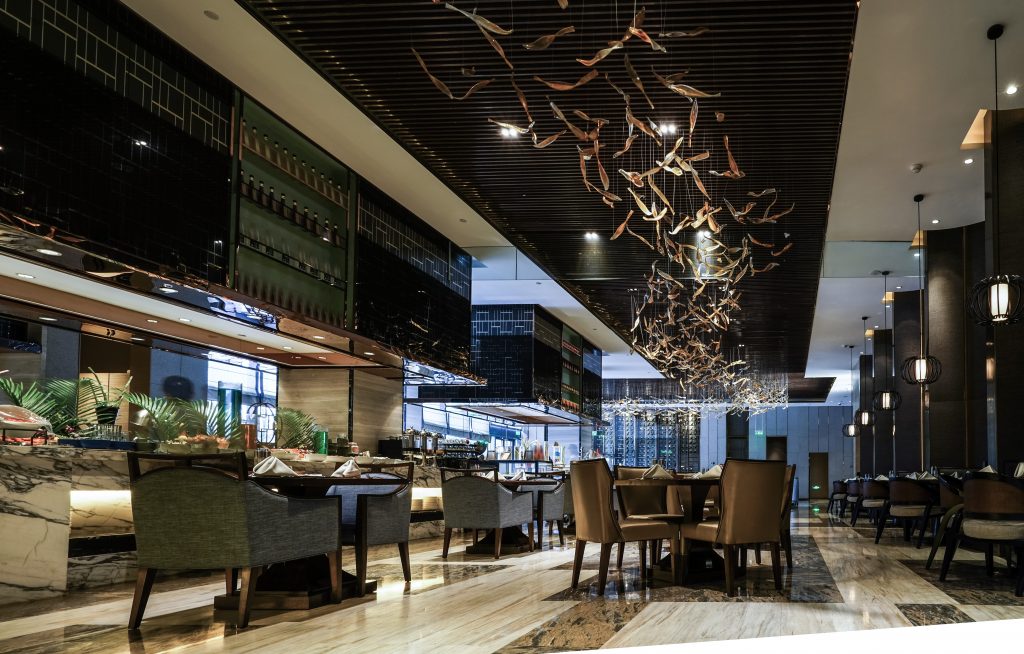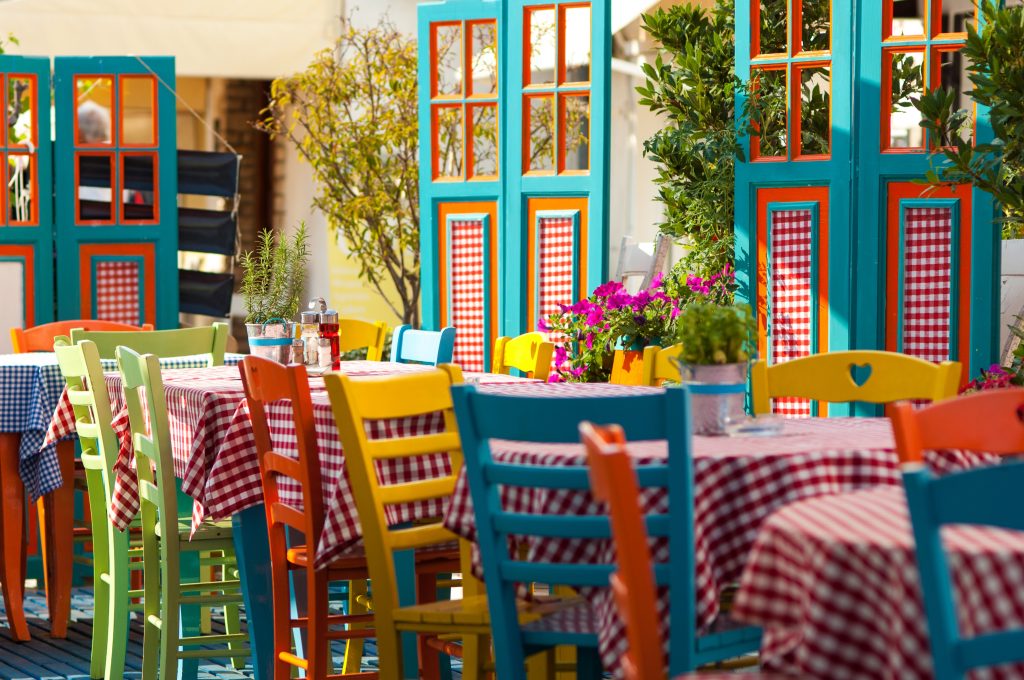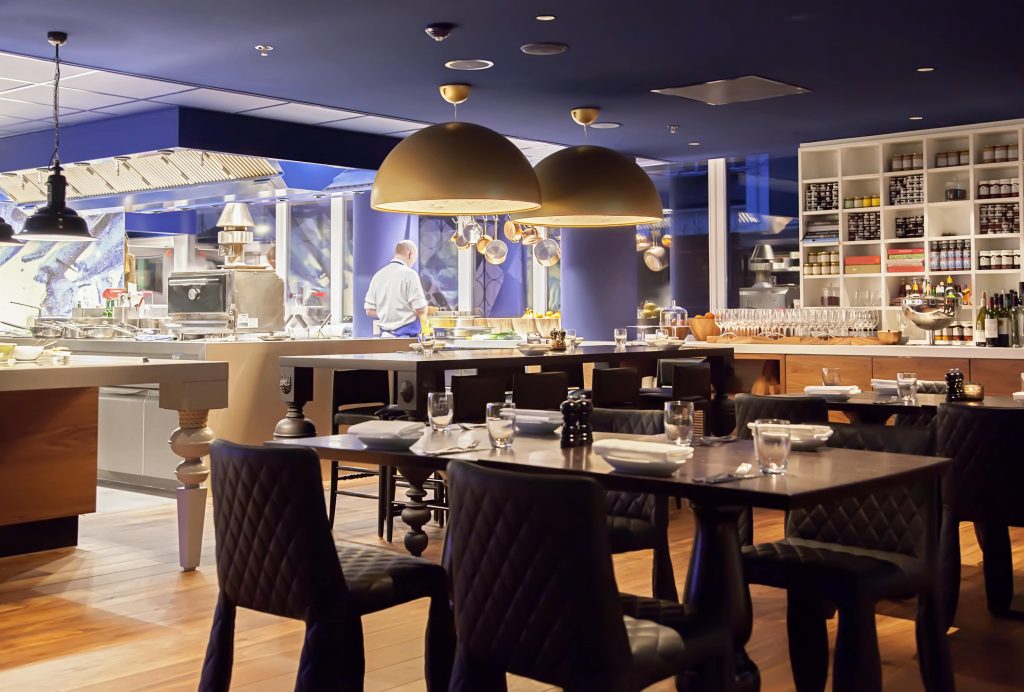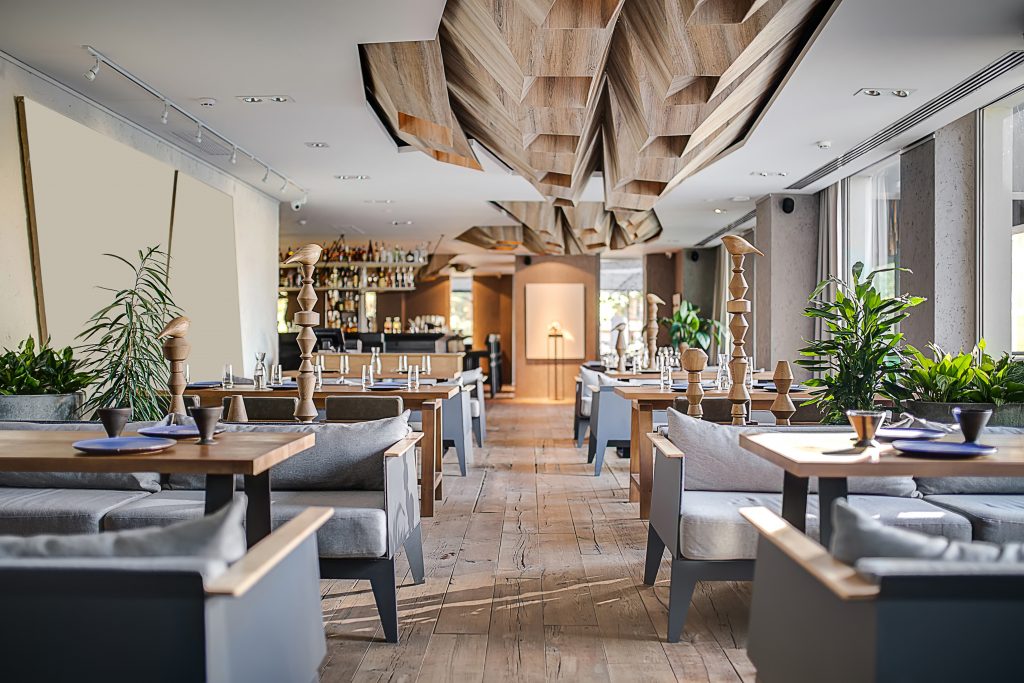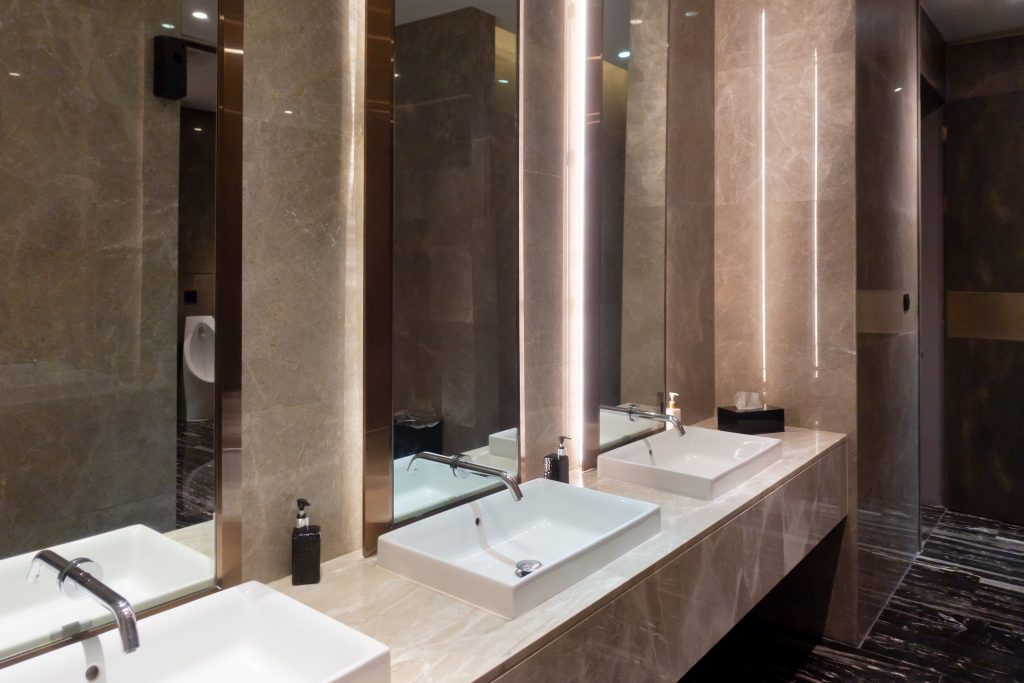All kinds of establishments that come under the category of food and beverage industry, be it restaurants, cafes, or ice-cream parlours, compete with each other mainly on the basis of the food that they serve. Other important factors include their location, prices or promotional tactics of various kinds.
However very few of them employ the power of a well thought out interior design in order to beat their competitors. Most people aren’t aware of this but you can use your restaurant’s interior design to alter your customers’ psychology.
This gives you the ability to control to a certain extent – how they feel inside your restaurant, what they’ll order and for how long they’ll stay.
Use your restaurant’s architectural design, seating arrangement, lighting setup, and music to influence your customers’ psychology. How? By using our ultimate restaurant interior design guide!
Here, we’ve enlisted everything you need to know on how to impact your customers’ psychology in a positive manner by using a strong restaurant interior design. Including also, some genius restaurant interior design tips and ideas that’ll help you decide what kind of interiors are going to work for your space.
Restaurant Interior Design Tips #1
1. Why Is Interior Design Important For Restaurant Businesses?
The restaurant interior design of your establishment is the first thing your customers notice as they walk into your restaurant for the first time. This first impression helps them decide what kind of service to expect, for how long they’d want to stay, and if they’d want to visit your place again or not.
Besides creating a good first impression, here’s why your restaurant needs an impressive interior design –
• Brand Value – How your restaurant looks is one of the most important aspects of your branding strategy. Depending on what kind of market or customer base you want to cater to, you need to choose a restaurant interior design and based on that, you can formulate an appropriate marketing strategy for promoting your restaurant.
• First Impressions – A dingy restaurant interior design creates a wrong impression in the minds of your diners, making them leave even before they decide to sit down and order something off the menu. Interiors which are too bright are a big no-no as well. They are equally disastrous for your restaurant’s reputation.
• Power of the Social Media – In today’s age and time, everyone loves to post pictures of the restaurants and cafes they’ve been to on social media platforms like Instagram, Facebook, and Snapchat. If your restaurant’s interior design is alluring enough, you will attract your customers’ entire lists of followers.
Make sure your restaurant receives ample natural light and the colour palette you’ve picked isn’t too bright or too dull.
• Stand Out From the Crowd – You can use your restaurant interior design to build a unique identity of your restaurant. Go for a restaurant interior design that highlights your specialities or USPs. People love such places that stand out from the crowd.
• Inspire Your Diners – And as we’ve mentioned above as well, with the help of a well thought out and executed restaurant interior design you can influence your customers’ psychology, inspiring them to feel or react in a certain way.
So, now that we’ve covered how important it is to invest in great restaurant interior design, let’s move on and discuss the four main elements of a restaurant’s interior design – colours, lighting, acoustics, and scents.
After this, we’ll discuss in detail, how to decide what kind of layout and architectural restaurant interior design would work for your space. Although first, let’s start with colours!
Restaurant Interior Design Tips #2
2. What Is The Importance Of Colour In Restaurant Interior Design?
It’s a well-known fact that your sight is your first source of information based on which you make most of your conclusions regarding the nature of your surroundings. This is especially true when you enter a new environment, for the very first time.
Restaurants who understand this little fact, make use of this wisdom to present their customers with the right kind of information regarding their establishments in order to create an excellent first impression that’ll last in their memories, forever.
Now, when it comes to vision, the use of colours is a very powerful tool at your disposal which you can use to influence your customers’ behaviour.
Depending on how powerfully you’d want to influence your customers’ appetites, there are three main ways to use colours in your restaurant’s interior design. These are – by using strong appetite stimulants, or by using the milder ones, and then there is something called as suppressants.
• Strong Stimulants – Have you ever noticed that no matter which fast-food chain you visit, red colour in some shade or form is always present in the background? Well, you aren’t imagining these things! Use of the colour red is known to be an effective way of stimulating your customers’ appetite.
Naturally, every restaurant would want their customers to enter their premises with a big appetite. But why red? This is so because the colour red increases your pulse rate and raises your blood pressure very effectively. It makes you feel hungry since your metabolic rate gets increased in that given moment. Also, people find red coloured foods incredibly appetizing.
Other strong stimulants include colours like yellow and orange. Yellow is the colour of happiness and is often associated with eating to one’s heart’s content. Whenever you see the colour yellow, your brain secretes the happy hormone – serotonin.
Thus, it enhances your mood because of which the food on your plate tastes better. Similarly, the colour orange is usually associated with comfort and warmth. So, orange also makes you feel safe & secure because of which you eat joyfully and comfortably.
• Milder Stimulants – The colour green, teal, and turquoise are considered to be milder appetite stimulants. Unlike red and yellow that represent sugar and carb-rich colourful fruits and vegetables, green foods are usually healthier and more nutrient-rich.
So, a lot of eco-friendly, pro-health, organic-food serving cafes and restaurants are going for such restaurant interior designs that are full of green colour in its various shades and hues.
• Suppressants – Colours like black, grey, purple and blue are known to be appetite suppressants. This is so because finding black, grey or blue-coloured foods that naturally exist in nature is very rare. Moreover, our ancestors knew that when your food turns black, blue or purple it means it’s time to throw that food out.
So, these colours are generally associated with rotten or poisonous foods. Which is why it’s best not to use these colours too much in your restaurant’s interior design. You can still use them, either as a secondary colour or by mixing them in equal proportion with their contrasting colours.
In fact, many famous food chains including Cafe Coffee Day have their main theme as purple. But you’ll always find a contrasting colour (red, in this case) used in an equal proportion to balance the purple out.
Restaurant Interior Design Tips #3
3. What Is The Importance Of Lighting In Restaurant Interior Design?
Now that you have a clear understanding of how different colours can impact your customers’ psychology, let’s explore the second most powerful element of a restaurant interior design that can be used to alter your customers’ emotions and actions – lighting!
What kind of lighting you choose for your interiors largely depends on what kind of theme or core concept you have for your restaurant. You can use your lighting setup to set a certain kind of ambience for your restaurant.
For example, recent studies show that spaces with ample sunlight make people feel happier and healthier. On the contrary, establishments with very little sunlight or a lot of artificial lights, makes people feel depressed or anxious.
It’s also important to remember that these days people visit restaurants and cafes to get Instagramable pictures for their online accounts. So, your restaurant should have at least a couple of such spaces where even an amateur photographer could easily click a few professional-looking shots because of great lighting.
Ultimately, these images will help you build a strong brand image on popular social media platforms and that too, for free!
But how to decide what kind of lighting is going to work for you? Below, we’ve described three main types of restaurant lighting setups. Mix and match as per your liking and availability of resources –
• Ambient Lights – These are your primary functional lights which are the main source of illumination in your restaurant. As the name itself suggests, ambient lights are responsible for creating a certain type of ambience for your space. Upscale restaurants usually go for low lighting setups, especially in their bar and lounge areas.
This helps them create an intimate, suave, and romantic ambience. On the other hand, most of the casual cafes, diners, or pizza joints, prefer going for a bright lighting setup as it creates an atmosphere of liveliness and an overall happy-go-lucky vibe.
• Task Lights – These are the lights that help your customers and employees perform different kinds of tasks such as – walking to their tables, reading the menu, clearly seeing what’s on their plates, cooking in the kitchen, serving the diners, etc. If you are choosing a low light ambience, make sure your task lights at the salad bar or at the buffet station are bright enough.
• Accent Lights – These lights are more decorative in nature than functional. Accent lights are used to draw the attention of your customers to certain specific areas or decorative objects to create an artistic impression. You can highlight your paintings, fountains, bar area, and sculptures with the help of these lights.
Restaurant Interior Design Tips #4
4. How Do You Choose A Lighting Setup For A Restaurant Interior Design?
So, with the use of these three different types of lights, you can create a well-structured lighting setup for your restaurant. But how to choose a setup for your particular restaurant? Well, depending on what kind of place you have – upscale or casual, a nightclub or a quick-service restaurant, different kinds of setups would work for you differently.
Here are a few restaurant interior design tips on how to pick a lighting setup for your restaurant –
• For an Upscale Restaurant – As we’ve mentioned above as well, a low-lighting setup with warm ambient lights works best for an upscale restaurant (especially during the dinner hours) as it creates an intimate, leisurely and romantic ambience.
Such a setup creates a comfortable and relaxed vibe because of which your customers tend to spend more time than they originally intended to. This means they’ll order an extra glass of wine or maybe a dessert or a coffee after finishing their meal. Use of wall lighting is usually preferred as compared to lights that fall directly onto the tables in such a setup.
• A Fast Food Restaurant – Use bright lights to make the space seem more spacious. Brighter lights also mean a smoother movement of your customers during the busy lunch hour. Use colours that are a part of your logo and use your accent lights to highlight these colours but in a subtle manner.
• A Cafe Style Restaurant – A relaxed and laid back atmosphere usually works well for a cafe-style restaurant. Facilitate natural lighting as much as possible and use your accent lights to highlight your interesting theme.
Restaurant Interior Design Tips #5
5. What Is The Importance Of Acoustics In Restaurant Interior Design?
How your restaurant looks is very important, right? But what about how your restaurant sounds? Is your restaurant too loud that your customers have to shout on top of their voices while talking to each other?
Or is it too quiet that the feel of your space makes them feel uneasy or bored? Ideally, a restaurant’s acoustics should feel like that of a house gathering. The vibe should be social, but no one should feel the need to shout at each other.
Well, the truth is that a whole lot of people tend to neglect acoustics while planning interior design for their restaurants. However, this could be a big mistake considering the fact that it’s one of the most technically challenging areas of your interiors.
Plus this could cost you a lot of money later on as you try to make the renovations. Also, you just can’t ignore the kind of positive impact a great acoustic design is capable of creating on your customers.
So, here’s how to choose that perfect acoustic design for your restaurant that’ll fulfil your requirements of both sound control and style.
If Your Restaurant is Too Loud – A note with something like, “your space is too noisy” is one of the top complaints most of the restaurateurs would find in their suggestion/complaint boxes. In fact, they have a name for it! It’s called the Lombard Effect – when diners can’t hear each other and hence they have to raise their voices, which in turn further raises the noise level of a restaurant.
The bad news is that if your restaurant is too noisy, it’ll distract your customers from tasting and smelling your food properly. Here’s what you can do –
- Make sure your restaurant interior design doesn’t have too many hard surfaces since they tend to amplify sounds in all directions.
- Make sure your noise generators and amplifiers aren’t facing each other.
- Do not go for an open kitchen design.
- On your crowded days, do not place tables too close to each other.
- Use carpets, linens, and drapes to absorb some of the noise.
- You can go for high ceilings and porous plasters. They also reduce noise levels quite effectively.
- Live piano music near the main entrance sets the mood right. It’s subtle, relaxing, and sounds simple.
- And of course, you can consider installing soundproofing panels for your doors and walls.
If Your Restaurant is Too Quiet – Yes, ‘too loud’ is usually the more common complaint, but ‘too quiet’ could also be a problem. It gives off the feeling that no one likes to go to this restaurant. When there’s too little noise, diners tend to become conscious about their conversations because they feel that what they are talking about can be heard by everyone in the room.
That makes them feel uncomfortable and you definitely don’t want that! Here’s what you can do –
- Since eating out is a social activity, make sure your diners feel comfortable carrying out their conversations. You can consider keeping an open kitchen design. Noises of food being prepared could help you maintain the right amount of noise levels.
- Live music of the right taste and kind is also a great idea.
- Place your speakers in walls and ceiling beams in a strategic manner.
Restaurant Interior Design Tips #6
6. What Is The Importance Of Scent In Restaurant Interior Design?
Restaurateurs use the element of scent in their restaurant interior designs not only to influence their diners’ moods and food choices but also, their spending habits. Recent studies have revealed that by using the right kind of scents you can boost your sales by up to 300 percent. Whoa! Now that’s not a small number, isn’t it?
Our sense of smell is our most primal or instinctive method of collecting information since our race comes from the ancestry of gatherers and hunters who used to live in the jungles. Whatever we smell, the limbic system of our brain analyses it. This same system is also responsible for regulating our moods, emotions, memory, and behaviour.
The memory part is particularly important here. How we react to a certain food is directly related to what kind of childhood memories we have of that food. For example, the scent of freshly baked choc chip cookies could easily transport you to those lazy, summer afternoons you had spent as a kid in your grandparents’ house. So, every time you smell the scent of cookies, you automatically feel happy and comforted.
This is why most of the bakery shops layout their freshly baked goods in their beautiful glass displays, filling the room with aromatic scents of cookies, pies, cakes, and muffins of all kinds. So, it becomes almost impossible not to order something once you are inside the bakery shop.
Restaurateurs use similar tricks to boost their sales by making use of tempting scents to make their customers feel great.
Here are our top restaurant interior design tips when it comes to picking the right scent-
- The smell of lavender, chamomile, and vanilla relaxes the brain. Your customers’ stress and anxiety levels go down and they feel more comfortable and at ease when the space is filled with such aromas.
- You can use the smell of apples and cucumbers to make your space feel bigger and airier. In this context, avoid the smell of barbecue smoke as it makes the room feel smaller and stuffier.
- The best way that’ll allow you to fill the room with different scents is to opt for open or semi-open kitchen design in your restaurant’s interiors. This will induce your customers’ appetite and with no or lesser walls between you and your diners, a sense of transparency is conveyed, which builds trust and honesty.
Restaurant Interior Design Tips #7
7. How Do You Choose Restaurant Interior Designs and Layouts?
What kind of layout and architectural design you’d pick depends on what kind and size of restaurant space you have at your hands. However, most floor plans can be divided into two main functional spaces –
• Front of the House – This includes your main entrance, lobby area, POS, dining area, and your bar or lounge.
• Back of the House – This includes the kitchen area, pantry, service entry doors, and the administration areas.
The idea is to keep these two areas distinctly separate from one another, but at the same time, easily accessible for your staff members. Based on this understanding, we’ll discuss different aspects of a restaurant’s layout and how to pick an appropriate design for each of these areas, as per your specific requirements. Let’s begin with the entrance design.
Restaurant Interior Design Tips #8
8. The Entrance Design
The entrance of your restaurant is a representation of what’s inside. It creates that crucial first impression in the mind of your customers, based on which they decide whether they’d want to try out your restaurant or not.
Here are a few restaurant interior design tips on what constitutes a great entrance design –
- Try to evoke curiosity in your customers’ mind with your entrance design. There should be ample space surrounding the entrance and the whole vibe should be pretty welcoming.
- The entrance should showcase the theme of your restaurant.
- It should always be well maintained and easy to access.
Restaurant Interior Design Tips #9
9. Decor & Furniture Design
This is probably the key element of your restaurant interior design that helps you build the core theme of your restaurant. However, while picking furniture, theme isn’t the only criteria, comfort of your diners should also be your top priority.
Here are a few restaurant interior design tips on how you should approach the furniture and decor design for your restaurant’s interiors –
- Not just the furniture, even the accessories including the paintings, sculptures, table centrepieces, and silverware that you pick should reflect the core theme of your restaurant.
- If you have a showcase worthy wine and coffee bar, go for well-polished wooden chairs or stools against the backdrop of tall glass windows.
- If you have an upscale restaurant, opt for sleek-looking leather sofas with majestic chandeliers, and similar decor. Such a place should have a low, warm-lighting setup and some classy tableware to go with the entire theme.
Restaurant Interior Design Tips #10
10. Picking A Dining Room Design
The dining area of your restaurant is where your diners spend most of their time. It is really the soul of your restaurant! Therefore, picking an ideal dining room design is a very crucial part of this process. Needless to say, the comfort and convenience of your customers should be your number one priority here.
Another very important aspect you have to keep in mind is the theme or the core concept of your restaurant. Most of the dining rooms can be divided into three main sections –
• The Seating Area – Ideally, there should be a minimum of three different sizes of tables to accommodate small, medium, and large-sized parties, conveniently. You can also place compact, two-persons’ tables near the windows of your dining area. As far as spacing is concerned, there should be a 3 to 4 feet (~1 metre) distance between any two adjacent tables to avoid any disturbances.
• The Waiting Area – Most people tend to avoid giving attention to this area while planning their interiors. But that’s not a good idea. When your place becomes popular, your customers tend to spend a considerable amount of time in the waiting area itself. Thus, there should be ample space in this area so that your diners could wait patiently and comfortably.
Putting up interesting paintings or posters is also recommended so that your diners could spend some time exploring these artworks while waiting for their turn to arrive.
• The Billing Area – This area should be positioned in such a way that it maximizes efficiency. Not too many staff members should be seen running up and down between your POS stations and customers tables, at any given point of time.
Restaurant Interior Design Tips #11
11. The Kitchen Design
The best tip we can give you for picking an ideal kitchen design is to actively involve your Head Chef in the process. Other people who could offer you valuable insights include your architect, kitchen consultant, and the contractor. The consultant would help you decide what kind of floor plan would work for your kitchen and what kind of stainless steel units, freezing units, etc would be needed and from where to get them.
The contractor would provide all the electrical and plumbing services after consulting with your architect and kitchen consultant.
Here are a few restaurant interior design tips on how to pick an ideal kitchen design for your restaurant –
• Mark Your Areas – Clearly mark in your kitchen’s floor plan where the pre-preparation and food assembly areas are going to be. Spaces for packing, washing, and storage should also be clearly defined from the very beginning to avoid any confusion.
• Movement and Ventilation – Make sure there’s enough space for your staff members to move around quickly and efficiently. Also, opt for a plan that has a great ventilation system so that your staff members would feel comfortable while working in the kitchen.
• Cooking Area – Allocate the maximum amount of space to your cooking area where the burners, grills, ovens and tandoors will be placed.
• Inventory Area – Allocate adequate space for the inventory area where you are going to store your food, goods, cooking equipment, cutlery etc. It is considered ideal to store equipment with similar functionalities together. The space where you’ll store all the dry goods should be completely moisture free and pest free. And there should be a dedicated cold storage area with requisite deep freezing facility for all your perishable goods like meat, seafood, etc.
• Staff Restrooms – It’s also a good idea to keep some space for employee restrooms and this area should ideally be located near the kitchen.
Restaurant Interior Design Tips #12
12. The Restroom Design
These days most of the restaurant owners understand that hygiene and cleanliness of their restaurant is such an important aspect they have to take care of if they want to give their customers a great dining experience. Cleanliness is important in the dining area, but it’s super important in the restroom area as well.
Even if you serve the best food in town, if your restrooms are dirty or poorly-maintained, there’s a high probability that most of your customers won’t ever return.
It’s best to have separate restrooms for males, females, and physically challenged customers. Make sure there’s ample lighting in these areas and they are thoroughly cleaned multiple times during the day. Mark where the restrooms are located so your diners won’t have to wander a lot in order to find them.
Conclusion
So, these are some of the most important aspects you need to take care of while conceptualising how you are going to build your unique identity in the market using your restaurant’s interior design.
Think of your restaurant’s interior design as a potent tool which you can use to gain popularity and trust of your customers.
By combining the power of an amazing menu, top-class service and your awesome restaurant interior designs, you’ll easily separate yourself from your competitors to become the best in the business, in no time!
Resources
If you found the above article helpful you may also be interested in:
- 7 Inexpensive Restaurant Design Ideas To Save You Thousands
- 20 Restaurant Interior Design Themes To Inspire Your Creative Genius
- Restaurant Fit Out Costs – Plus, 5 Expert Tips To Save You Thousands
- Restaurant Startup Costs – Plus, 10 Crucial Key Points To Fail-Proof Your Budget
- Cafe Interior Design – 7 Ideas, Tips & Tricks For 2020
- Opening A Bar In Sydney – An Impeccable Guide In 2020
- Cafe Design – An Impeccable Guide In 2020

